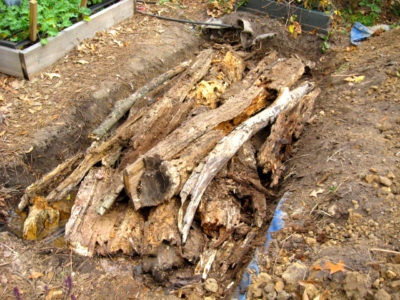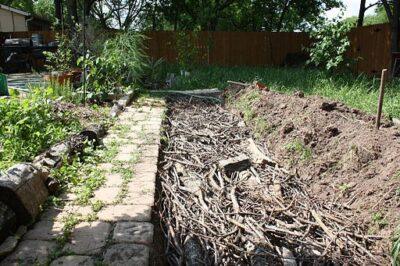Looking for a productive way to grow food that requires less work?
Utilized in Germany and Eastern Europe for hundreds of years, hugelkultur (literally meaning “mound culture”) is a method of growing food that can be built using locally available materials. Because this growing technique applies principles that are found in nature, you get nature’s help to produce food efficiently without many of the challenges that come with a conventional tillage garden.
Hugelkultur is an innovative gardening and farming technique that builds the fertility of the soil, retains soil moisture (making it a good option in drought-prone regions), allows for good soil drainage, reduces the need to weed, and provides a great way to use extra woody materials that are lying around on your property.
Hugelkultur works by burying woody materials, such as logs, branches and twigs, under soil, and then growing plants on top of the buried mound. The wood in hugelkultur beds soaks up water like a sponge, providing moisture to the plants, and the decomposing wood continually feeds the soil in the bed.
Hugelkultur mimics the natural conditions found within a forest, where plants grow on top of decaying trees. Basically, hugelkultur is the composting of organic materials in the same space where you are growing plants.
If you have the luxury of allowing your prepared hugelkultur bed to sit for a number of months before planting in it, such as building the bed in the fall for the following spring, it is a useful way to let things start breaking down ahead of your growing season. However, you can certainly plant seeds or transplants immediately in your newly constructed garden bed.
Because hugelkultur beds continue to enrich the soil as the wood breaks down over many years, they increase their productivity over time with very little work involved. After such a system is established, it will continue to virtually fertilize itself for years without much additional input.
Your Best Source For Non-GMO Seeds Is Right Here! [2]
Having a growing system like hugelkultur that incorporates woody materials encourages the growth of mycorrhizal [4] fungi that are so important in productive natural ecosystems. When present within a garden bed, the mycorrhizal fungi increase the resistance of the soil and your plants to pests and diseases, as well as facilitate nutrient absorption by plant roots.
Hugelkultur also offers a great way to store carbon in the soil and to utilize wood as a resource for your garden instead of burning the wood and releasing its carbon into the atmosphere.
Practical Applications for Hugelkultur
Hugelkultur is an especially useful growing technique where soil conditions are poor, such as compacted soils, poor soil drainage, and soil with poor water retention such as those soils that are often present in urban areas.
The hugelkultur method can be applied to a number of different forms, including within traditional raised bed structures, above the ground in tall mounds, or below the ground in buried ditches. One of the advantages of the above-ground hugelkultur mounds is that you can grow on different aspects, such as on the sides, on the top, and on the ends of the mound.
Generally, the bigger and the taller that a hugelkultur mound is, the better, because an increase in mound size encourages more oxygenation of the contents inside, and promotes the best growing conditions, including optimal growth of mycorrhizal fungi inside the mound.
Hugelkultur beds can be used to grow a seasonal vegetable garden, but they can also be used to grow perennial plants on landscapes including fruit trees, shrubs, and other types of trees, and for creating swales on contour that water the garden bed, hold water high on the landscape and help to recharge ground water supplies.
Choosing Wood for Your Hugelkultur Bed
When it comes to building a hugelkultur bed, the choice of wood is very important. Wood from trees like cedar, black cherry, black locust and black walnuts either do not decompose easily, or they contain plant chemicals that would inhibit plant growth. Wood choices that work well in hugelkultur beds include alder, maple, apple, cottonwood, poplars, willow and birch.
Rotting wood is the best choice to help get your hugelkultur bed going faster. However, if you have freshly cut wood, you may need to add sources of nitrogen to your bed, such as composted manure and kitchen scraps. Adding these sources of nitrogen compensates for the fact that freshly cut wood is high in carbon and would lead to “nitrogen stealing” from within the bed, thereby reducing the amount of nitrogen that is available to your growing plants.
How to Build a Hugelkultur Bed
Materials needed:
- Logs, branches, twigs and other woody materials from trees that do not have allelopathic [5] plant compounds that would inhibit the growth of other plants. Dead leaves are also a useful resource to use for your bed.
- Nitrogen-rich materials, such as composted manure and fruit and vegetable scraps from your kitchen.
- Topsoil, if you are burying the woody materials above ground (otherwise you would cover the wood with the soil from the ditch that you dug). You will want enough to cover all of the woody materials with one to two inches of soil.
Directions:
1. Lay down several layers of cardboard or newspaper to block any perennial weeds that exist in the spot that you will build your hugelkultur bed on.
This New All-Natural Fertilizer Doubles Garden Production! [6]
2. Lay down the largest woody materials like logs as the first layer of the bed. Next, lay down the smaller woody materials like branches and twigs. A minimum height of three feet is suggested for a hugelkultur bed, but as mentioned above, bigger is definitely better when it comes to building a hugelkultur bed. While you could certainly lay out a straight rectangular hugelkultur garden bed, you could instead choose different bed configurations, such as a keyhole garden shape [7] that will allow easy access to your entire garden bed within arm’s reach.
3. Water everything very well.
4. Fill in the gaps between the woody materials with the nitrogen-rich materials, such as your kitchen scraps and composted manure. You can also add the dead leaves at this point to provide extra bulk and extra carbon.
5. Cover the mound of materials with enough soil to cover everything in the bed with a one to two inch layer of topsoil.
6. Add mulch materials such as straw to help reduce soil erosion, to prevent weeds from becoming established in the bed, and to help retain moisture at the soil’s surface in your new hugelkultur bed. You could also anchor the mulch into the bed with sticks to help hold it in place.
Have you ever built a hugelkultur bed? What advice would you add? Share it in the section below:
Every Year Gardeners Make This Avoidable Mistake — But You Don’t Have To. Read More Here. [8]

